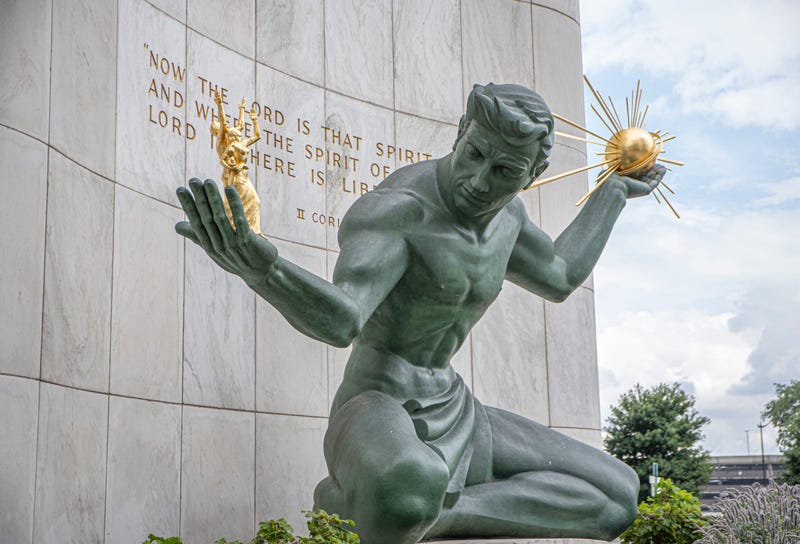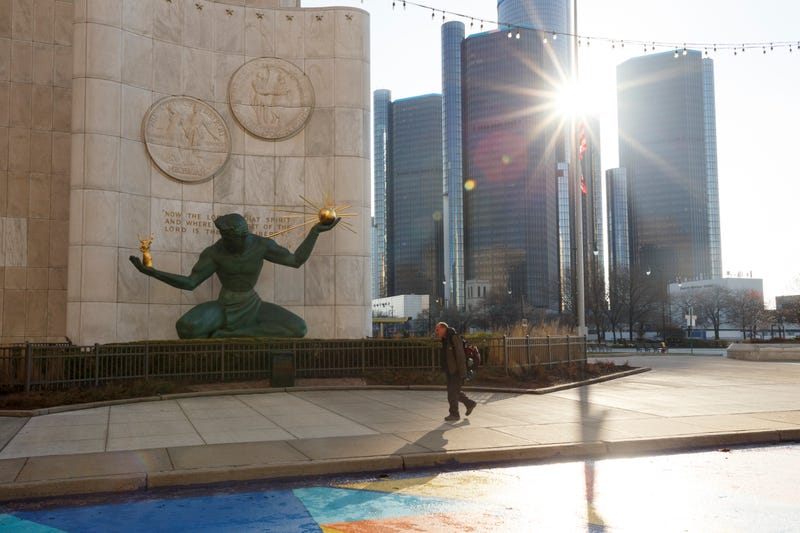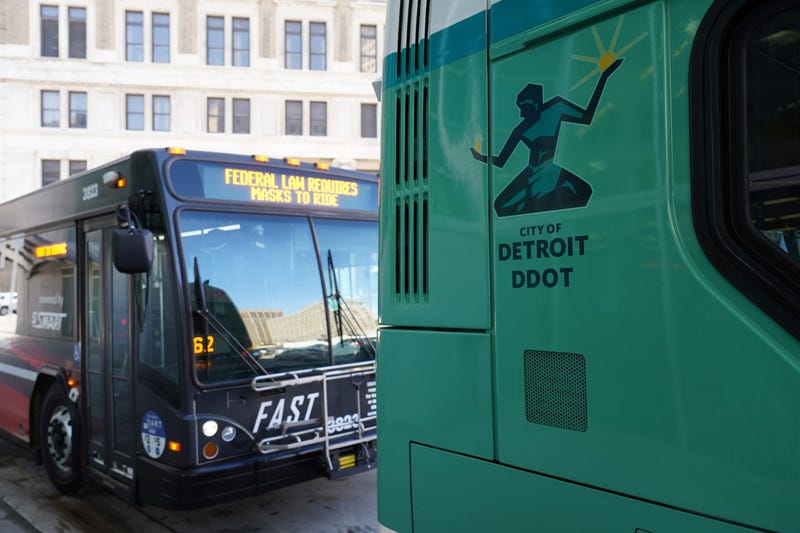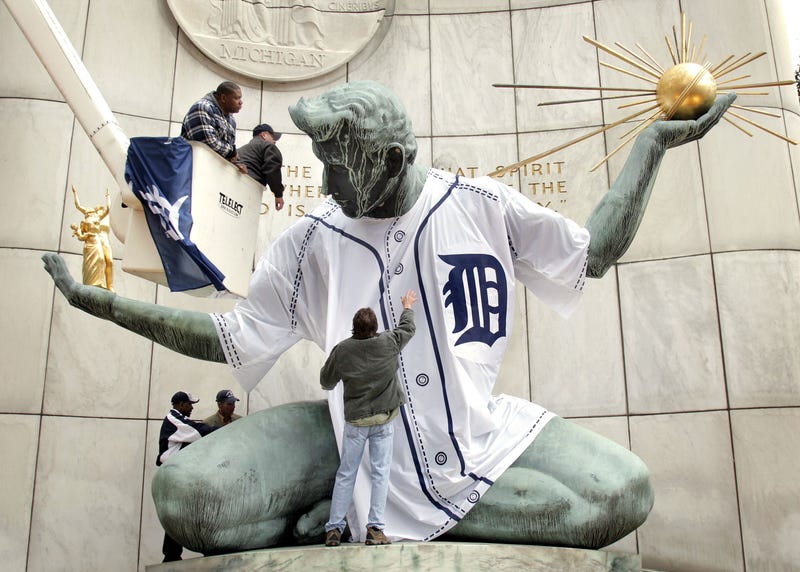
DETROIT (WWJ) -- When visitors come to Detroit, many are curious which of the city’s most iconic landmarks they should see while they’re in town.
One that is undoubtedly suggested every time is the Spirit of Detroit monument outside the Coleman A. Young Municipal Center, which is right in the heart of the city’s downtown area.
Today (Sept. 23) the "Spirit" turns 66 years old, and while the image of the sculpture is incredibly recognizable, there’s plenty of history behind this stunning piece of public art that might not be as widely known.
On an April episode of The Daily J podcast, WWJ’s Zach Clark and Annie Scaramuzzino carved out some of those facts, and learned the fascinating story behind the sculpture that came to symbolize the Motor City.
How Detroit got the “Spirit”
The “Spirit" sculpture was commissioned by the Detroit-Wayne Joint Building Authority in 1955 to mark the entranceway of the new City-County Building. At the time, the piece was estimated to have cost the city around $58,000, though sculptor Marshall Fredericks waved his payment to honor what he believed was his civic duty.
Cast in Oslo, Norway, the statue underwent acidic treatments to oxidize the bronze, giving it that iconic green color. At the time, it was reported to be the largest bronze statue of its kind since the Renaissance.
After making the 3,385-mile journey from Norway to Detroit, the statue was put into place and dedicated on Sept. 23, 1958 outside what we now know as the Coleman A. Young Municipal Center.
What is the "Spirit" meant to represent?
The 26-foot statue can be found at 2 Woodward Avenue in Downtown Detroit. In the statue's left hand is a gilt-bronze sphere emanating rays that symbolize God or divinity and three rings representing the trinity. In its right hand is a family, symbolizing all human relationships.
"The artist expresses the concept that God, through the spirit of man, is manifested in the family, the noblest human relationship," reads the inscribed plaque in front of the statue.

It’s not actually called the “Spirit of Detroit”
...And it's not called "The Jolly Green Giant" either, though that has become a popular nickname for the statue.
Its most common moniker is a reference to the bible verse carved on the marble wall behind the statue -- a quote which actually served as Marshall Fredericks' inspiration for sculpture's concept:
"Now the Lord is that Spirit and where the Spirit of the Lord is, there is Liberty (II Corinthians 3:17)."
In fact, Fredericks never formally named the statue, but over time, Detroiters began referring it as "The Spirit" or the "Spirit of Detroit" thanks to the wall with the bible verse. That wall also features the seals of both the city of Detroit and Wayne County, the latter of which Fredericks also designed.
Marshall Fredericks’ design decisions helped define Detroit
Almost immediately after its completion, the Spirit of Detroit came to symbolize the city as a whole -- and its popularity has only grown over time.
In a 1995 interview with Mary Iorio of Cranbrook -- where Fredericks previously worked -- the artist explained the city brought in representatives from different religions to ensure the Spirit would resonate with all citizens.
"I hoped that they would feel the city was in the hands of God, so to speak, that they were protected in some way and that it would be better. Positive thoughts," Fredericks said.
These days, the Spirit also serves as a community symbol, and appears as an official city insignia on signs, buses, and even manhole covers across Detroit. Additionally, the statue's iconic green hue has become one of the city's defining colors.

He’s an expensive dresser — and fitting him is a process
Perhaps the most popular tradition surrounding the Spirit of Detroit involves the statue donning the jerseys of sports teams from Detroit or the state of Michigan.
Through the years, the Spirit of Detroit has worn giant jerseys representing the Detroit Red Wings, Tigers, Lions and Pistons, as well as the Michigan Wolverines and Michigan State Spartans. Most recently, the statue was dressed in a custom 2024 NFL Draft jersey for the big event back in April.
Sharon Madison, Chair of the Detroit-Wayne Joint Building Authority, tells WWJ that it costs $25,000 to dress the Spirit, and the team who is interested in having him wear their jersey is responsible for the bill. That money then goes back into the fund that is reserved for the sculpture's maintenance.
Additionally, the same third-party company is always used to create the jerseys and dress the Spirit, in order to maintain the sculpture's quality and integrity as much as possible during the process. Madison says creating the jerseys takes about two-to-three days, and dressing him is at least a two-person job that takes about 30 minutes.

There’s an entire museum of Marshall Fredericks’ works you can visit in Michigan
Marshall Fredericks was not originally from Michigan, but moved to the Metro Detroit area in 1932 to work at the Cranbrook Academy of Art and Cranbrook and Kingswood School in Bloomfield Hills.
After enlisting and serving as a lieutenant colonel in the Air Force in WWII, he later returned to Michigan and began his career as a public artist.
Along with the Spirit of Detroit, Fredericks is responsible for many notable pieces of public art that can be found across our region, including the Levi L. Barbour Memorial Fountain on Belle Isle and the Star Dream Fountain in Downtown Royal Oak.
In fact, there is an entire museum dedicated to Marshall Fredericks and his works on the campus of Saginaw Valley State University. The Marshall M. Fredericks Sculpture Museum is open to the public and free to visit.
